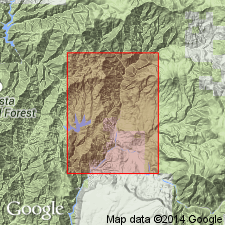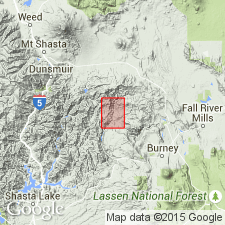
- Usage in publication:
-
- Hawkins Creek member
- Modifications:
-
- First used
- AAPG geologic province:
-
- Klamath Mountains province
Summary:
Hawkins Creek member of Modin formation. Lowest member of formation. Underlies Devils Canyon member (new); overlies Brock shale. Age is Late Triassic.
Source: US geologic names lexicon (USGS Bull. 1200, p. 1707).

- Usage in publication:
-
- Hawkins Creek member
- Modifications:
-
- Original reference
- Dominant lithology:
-
- Volcanics
- AAPG geologic province:
-
- Klamath Mountains province
Summary:
Pg. 6, 9-10, pl. 1. Hawkins Creek member of Modin formation. Formal proposal of name. Consists of series of beds of volcanic material in form of conglomerate, agglomerate, volcanic breccia, and tuff. Maximum thickness about 900 feet. Underlies Devils Canyon member; overlies Brock shale. Age is Late Triassic.
Type area: section in Devils Canyon beginning at contact with overlying Devils Canyon member about 1 mi west of confluence of Devils Canyon and Alder Creek, extending west along Devils Canyon to contact with Brock shale, Big Bend quadrangle. Shasta Co., northern CA. Named from exposures near head of Hawkins Creek in vicinity of Little Meadows.
Source: US geologic names lexicon (USGS Bull. 1200, p. 1707).
For more information, please contact Nancy Stamm, Geologic Names Committee Secretary.
Asterisk (*) indicates published by U.S. Geological Survey authors.
"No current usage" (†) implies that a name has been abandoned or has fallen into disuse. Former usage and, if known, replacement name given in parentheses ( ).
Slash (/) indicates name conflicts with nomenclatural guidelines (CSN, 1933; ACSN, 1961, 1970; NACSN, 1983, 2005, 2021). May be explained within brackets ([ ]).

